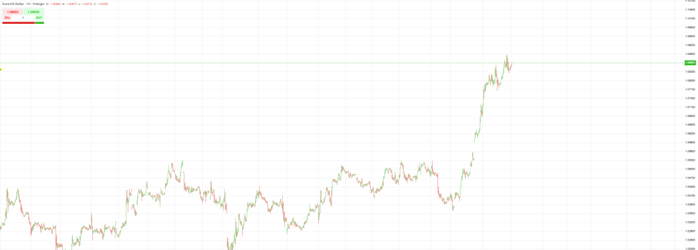
The Dollar’s Historic Drop and the Shifting Forex Market
 ACY Securities - Luca Santos
ACY Securities - Luca Santos
This past week has been nothing short of historic for the FX markets. The U.S. dollar saw a dramatic sell-off, with the DXY index plummeting between 3.5% and 4.0%. Such sharp declines have been rare in recent history, with only two comparable instances—November 2022, when easing inflation fears triggered a 4.1% drop, and March 2020, during the COVID-induced market turmoil. The core driver of this recent move? A sudden and aggressive shift in European fiscal and monetary dynamics.
DXY H1 Chart

Europe’s Bold Move and the Euro’s Resurgence
Germany’s announcement of significant fiscal easing has altered the Eurozone’s growth outlook. For years, restrictive spending policies, particularly the constitutional debt brake implemented in 2009, have constrained economic expansion. Now, with Berlin signalling a willingness to loosen the reins, European yields have surged, forcing markets to rapidly reprice expectations. The German 10-year Bund yield saw an astonishing 30-basis-point jump in a single day—an event that typically signals profound shifts in market sentiment.
The euro’s strength has been further amplified by growing confidence in the region’s recovery trajectory. MUFG’s research suggests that, historically, following outsized moves in German bond yields, EUR/USD tends to appreciate for up to two months before stabilizing. However, this doesn’t mean the euro’s ascent will be uninterrupted—external risks, including potential U.S. tariff actions and lingering economic fragilities, still loom.
EURUSD H1 Chart

U.S. Economic Slowdown: Real or Premature Panic?
While the dollar’s rapid decline suggests market participants are pricing in a U.S. economic slowdown, the data presents a more nuanced picture. January’s retail sales fell sharply, and consumer confidence has weakened, yet nonfarm payrolls remain resilient, complicating the Federal Reserve’s path forward. The latest jobs report showed an increase of 151,000, a softer print but not necessarily indicative of a recession. However, a sharp rise in corporate layoffs—comparable to early COVID-19 levels—raises concerns about the sustainability of U.S. employment strength.
Moreover, net trade is set to be a major drag on U.S. GDP, with the trade deficit widening to a record $155.6 billion in January. The Biden administration’s approach to tariffs, particularly in response to China’s economic manoeuvres, could further weigh on growth. Markets are now pricing in at least two, possibly three, rate cuts from the Fed this year, with the first move expected as early as June.
The Yen’s Steady Rise Amid Shifting Risk Appetite
Another key trend emerging from this week’s FX market shake-up is the yen’s resilience. Japanese government bonds (JGBs) have been experiencing steady yield increases, reducing the appeal of yen-funded carry trades. The 10-year JGB yield recently hit 1.55%, reinforcing the notion that Japan’s prolonged ultra-loose monetary policy era may be ending.
JGB 10Y

Additionally, the Ministry of Finance’s data suggests foreign investors are showing renewed interest in Japanese fixed income. In the last month, Japanese investors have sharply reduced speculative short positions against the yen, indicating a shift in market sentiment. Should the Bank of Japan proceed with further policy tightening, the yen could continue its upward trajectory, particularly against the euro and dollar.
The Canadian Dollar Faces Pressure from U.S. Trade Tensions
While much of the FX market’s focus has been on the dollar’s decline and the euro’s rally, the Canadian dollar has struggled to find traction. The Bank of Canada (BoC) is facing mounting pressure to cut rates further, particularly considering increased U.S. trade restrictions. The Trump administration’s recent tariff hikes on Canadian imports have created fresh headwinds for the CAD, with the market now pricing in another 25-basis-point cut from the BoC next week.
Interestingly, despite stronger-than-expected Canadian GDP growth in Q4 (2.6% annualized), trade-related disruptions could overshadow recent economic momentum. Canada’s trade surplus with the U.S. surged to a record CAD 14.4 billion in January, driven by front-loaded exports ahead of anticipated tariff increases. However, if retaliatory measures escalate, the CAD could remain on the back foot.
Outlook: Is This the Start of a Prolonged Trend?
While this week’s FX volatility has been striking, the question remains: is this the start of a long-term trend, or merely a short-term correction? Several factors will dictate the path forward:
- Europe’s Follow-Through: If Germany and the broader Eurozone deliver on fiscal expansion promises, the euro could sustain its recent gains.
- U.S. Economic Resilience: Should the U.S. avoid a deeper slowdown, markets may have overestimated the Fed’s urgency in cutting rates.
- Tariff Uncertainty: With global trade policy in flux, geopolitical risks remain a wildcard, particularly if the U.S. implements broader protectionist measures.
For now, the dollar’s downward momentum is undeniable, but history suggests that FX trends rarely move in straight lines. A near-term bounce-back in Q2 remains a distinct possibility, particularly if markets reassess the severity of U.S. economic risks. However, should the current macroeconomic themes persist, we may be witnessing the early stages of a more profound shift in global currency dynamics.
This content may have been written by a third party. ACY makes no representation or warranty and assumes no liability as to the accuracy or completeness of the information provided, nor any loss arising from any investment based on a recommendation, forecast or other information supplies by any third-party. This content is information only, and does not constitute financial, investment or other advice on which you can rely.
LiquidityFinder
LiquidityFinder was created to take the friction out of the process of sourcing Business to Business (B2B) liquidity; to become the central reference point for liquidity in OTC electronic markets, and the means to access them. Our mission is to provide streamlined modern solutions and share valuable insight and knowledge that benefit our users.
If you would like to contribute to our website or wish to contact us, please click here or you can email us directly at press@liquidityfinder.com.
